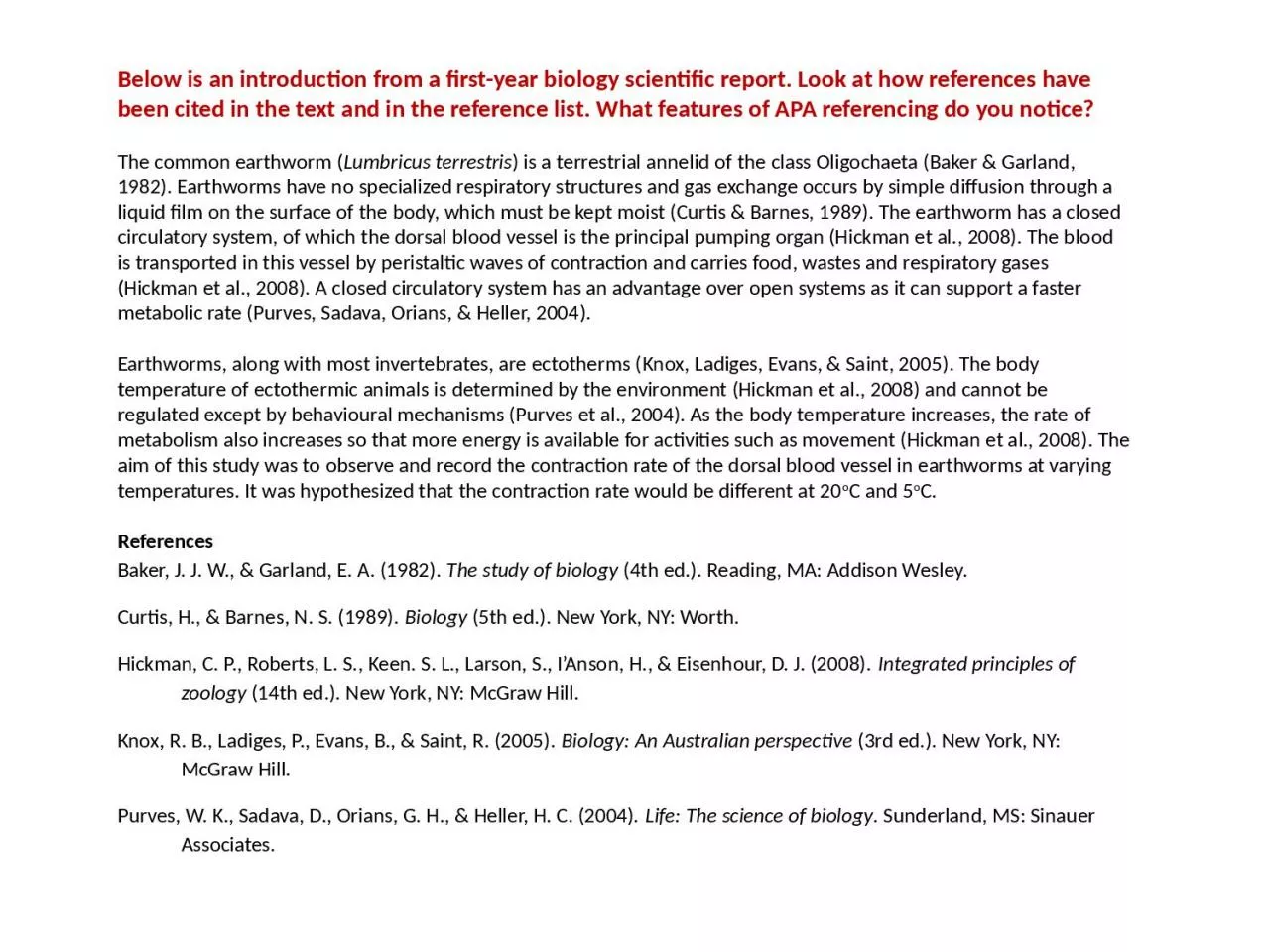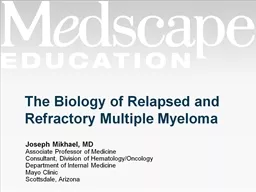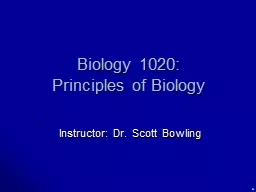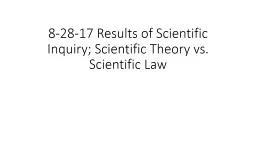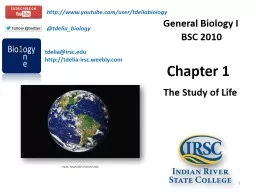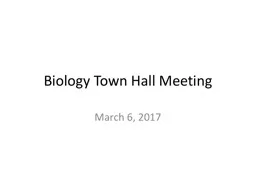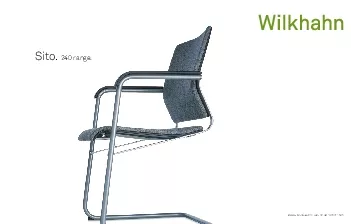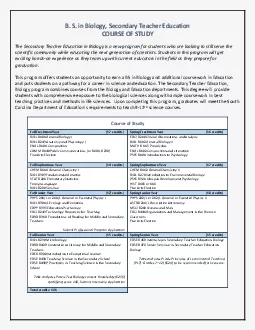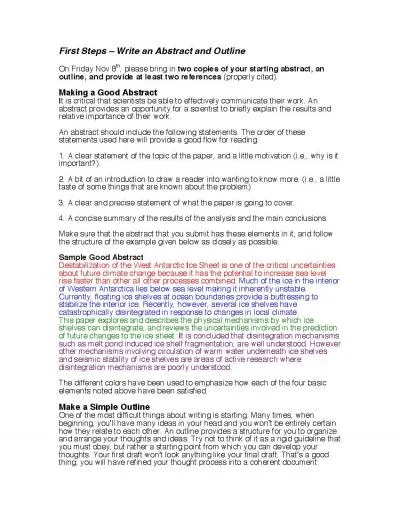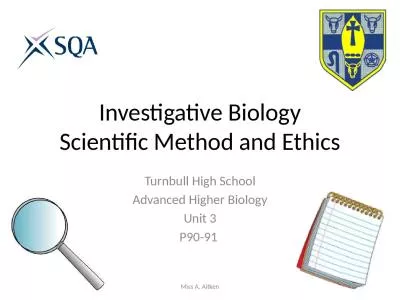PPT-Below is an introduction from a first-year biology scientific report. Look at how references
Author : mackenzie | Published Date : 2024-01-13
The common earthworm Lumbricus terrestris is a terrestrial annelid of the class Oligochaeta Baker amp Garland 1982 Earthworms have no specialized respiratory
Presentation Embed Code
Download Presentation
Download Presentation The PPT/PDF document "Below is an introduction from a first-ye..." is the property of its rightful owner. Permission is granted to download and print the materials on this website for personal, non-commercial use only, and to display it on your personal computer provided you do not modify the materials and that you retain all copyright notices contained in the materials. By downloading content from our website, you accept the terms of this agreement.
Below is an introduction from a first-year biology scientific report. Look at how references: Transcript
The common earthworm Lumbricus terrestris is a terrestrial annelid of the class Oligochaeta Baker amp Garland 1982 Earthworms have no specialized respiratory structures and gas exchange occurs by simple diffusion through a liquid film on the surface of the body which must be kept moist Curtis amp Barnes 1989 The earthworm has a closed circulatory system of which the dorsal blood vessel is the principal pumping organ Hickman et al 2008 The blood is transported in this vessel by peristaltic waves of contraction and carries food wastes and respiratory gases Hickman et al 2008 A closed circulatory system has an advantage over open systems as it can support a faster metabolic rate . 57347E57347LQFUHDVLQJ57347LQYHVWPHQW57347LQ57347WKH57347UH57567QHPHQW57347 5744157454574445737657458574495744757455574585745557461574595737657445574625744157452574615744157460574495745557454573765745557446573765746057448574455737657453574555745957460 Topics. Current Treatment Options for Relapsed/Refractory Multiple Myeloma. Topics. Relapsed/Refractory MM. Treatment Goals and Strategies. Relapsed/Refractory MM. Exposure to Stem Cell Toxic Agents Not An Issue for Most Patients . Principles of Biology. Instructor: Dr. Scott Bowling. Today’s Lecture Topics. Active learning. Course syllabus / other initial business. Chapter 1: The Science of Biology. Groups of 3-4. 1 sheet of paper; answer:. Hosted by: . Dr. Robin Cameron,. Associate Chair (undergraduate). Alex . Ognjanovic. , . BioSociety. 2. nd. Year Welcome. introduce faculty members in Biology. g. et insight into your current/future biology courses . 8-28-17 Results of Scientific Inquiry; Scientific Theory vs. Scientific Law Do Now: Answer the following question in your Science Notebook. Why might you engage in scientific inquiry? We do so to find answers to questions about nature. Chapter 1 General Biology I credit : NASA/GSFC/NOAA/USGS The Study of Life BSC 2010 1 tdelia@irsc.edu http://tdelia-irsc.weebly.com @tdelia_biology http://www.youtube.com/user/tdeliabiology Timeline of Life on Earth March 6, 2017. Get Involved. Scientific Writing Workshop, . 4:30-6pm April 5-6 at Writers House. Annual Biology Chair Cup Soccer Tournament, team registration deadline . April 1st. Peer Mentor for 2017-2018 application deadline . Technical detailsDesignsModels and dimensionsAwardsstandardsand certificatesAccessories and other itemsTechnical detailsViews and referencesTechnical detailsDesignsModels and dimensionsAwardsstanda COURSE OF STUDY The Secondary Teacher Education in Biology is a new program for studentswho are looking to still serve the scientific community while educatingthe next generation of scientists Student Nature guide to authors First paragraphs for Letters Information sheets 3d How to construct a Nature summary paragraph Annotated example taken from Nature 435 114118 5 May 2005 One or two sentences . Balantidium. . coli. o. nly Ciliate . known to be pathogenic to humans. . t. he . largest protozoan parasite of humans. . p. rimarily . a parasite of pigs, with strains adapted to various other . ;. . the. . study of . biology. at the . molecular. level.. Molecular biology. ;. . the. . study of . gene . structure and functions at the . molecular level. . to understand the molecular basis of hereditary, genetic variation, and the expression patterns of genes. . Turnbull High School. Advanced Higher Biology. Unit . 3. P90-91 . Miss A. Aitken. The Scientific Research Cycle. The scientific research process consists of several different steps including:. What do I want to find out?. Prepare for your AP Biology exam with confidence using these expertly crafted questions and answers. Dive into key topics and gain insights into effective study strategies.
Download Document
Here is the link to download the presentation.
"Below is an introduction from a first-year biology scientific report. Look at how references"The content belongs to its owner. You may download and print it for personal use, without modification, and keep all copyright notices. By downloading, you agree to these terms.
Related Documents

